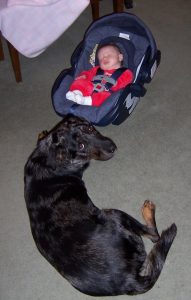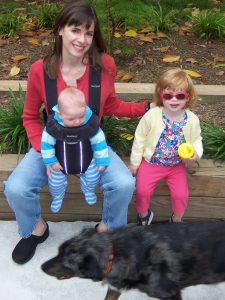The dog training school where I teach has a exciting new partnership with Babies-R-Us: We’re about to start monthly seminars for expecting and new parents on finding your “new normal” with a baby plus a dog. I’m using today’s post to organize my thoughts and brainstorm a bit. I’ll lay out the best advice I’ve gathered from my research and toss out some insights from personal experience. I’m also inviting readers–other trainers, dog lovers, parents–to share their knowledge, success stories, and cautionary tales.
 I’m a mom myself. In addition to my fabulous husband, my family includes two school-age humans (or as I call them, humans-in-training), one dog, one cat and two rabbits. That’s a lot of moving parts, but usually the machinery of our multi-species household runs with few glitches. Eleven years ago, when I brought home my first newborn baby, I had a different dog, and I wasn’t a trainer. Although I’d had dogs all my life, I was missing a lot of information that could have helped me make the transition to post-baby life a bit easier on my dog. Luckily for all of us, my dog Sachem was a pretty unflappable girl, and my husband’s and my intuition about how to keep Sachem from feeling exiled from life on Planet Baby was sufficiently on-target to avoid trouble. But if I had it to do over again, I’d take advantage of the multitude of great resources out there, especially from top-notch dog+kid gurus like Colleen Pelar (www.livingwithkidsanddogs.com), Jennifer Shryock (www.familypaws.com) and Joan Orr (www.doggonesafe.com). I’m looking forward to the chance to bring their insights, along with those of fellow trainers, and a few of my own, to parents just embarking on this wild ride. I want people to come away from these seminars feeling the advice was, above all else, reassuring and realistic.
I’m a mom myself. In addition to my fabulous husband, my family includes two school-age humans (or as I call them, humans-in-training), one dog, one cat and two rabbits. That’s a lot of moving parts, but usually the machinery of our multi-species household runs with few glitches. Eleven years ago, when I brought home my first newborn baby, I had a different dog, and I wasn’t a trainer. Although I’d had dogs all my life, I was missing a lot of information that could have helped me make the transition to post-baby life a bit easier on my dog. Luckily for all of us, my dog Sachem was a pretty unflappable girl, and my husband’s and my intuition about how to keep Sachem from feeling exiled from life on Planet Baby was sufficiently on-target to avoid trouble. But if I had it to do over again, I’d take advantage of the multitude of great resources out there, especially from top-notch dog+kid gurus like Colleen Pelar (www.livingwithkidsanddogs.com), Jennifer Shryock (www.familypaws.com) and Joan Orr (www.doggonesafe.com). I’m looking forward to the chance to bring their insights, along with those of fellow trainers, and a few of my own, to parents just embarking on this wild ride. I want people to come away from these seminars feeling the advice was, above all else, reassuring and realistic.
I remember how it feels to be a new mom. You’re walking on air but scared to death. You’re exhilarated but exhausted. You want to do everything perfectly but sometimes you feel like you can’t do anything right. Meeting your baby’s limitless needs drains most of your physical and emotional energy; everybody else better take a number and get in line. You worry you’re breaking your dog’s heart. You hope your dog will learn to love your baby as much as you do, but fear if you turn your back for one second, your dog may gobble her up. You crave guidance about how to make this all work for you, your baby and your dog. BUT…it better be doable. It better not take a @#$%&! village. It should require only as much cognitive function as the average person can muster on 3 hours of sleep. What I want these expecting and new parents to hear from me is, “Don’t worry, you CAN do this!”, not “You’d better do this, and not do that, and any mistake you make is going to ruin everything forever.”
So with all that in mind, here’s some of the stuff I plan to share, based on my own experience, discussions with fellow trainers, and astute advice from dog experts I respect. And I’m eager to hear from readers: What recommendations have you given or received? What pearls of wisdom do you offer? What do know now that you wish you’d known then?
Preparing your dog before your baby arrives
Acclimate your dog to new routines
Ok, let’s face it. Life with a newborn is unpredictable, so envisioning our new schedules and habits in explicit detail isn’t very realistic, is it? But there are a couple obvious things that may change.
If you plan to make changes to where your dog can and can’t go, you can start getting him ready now. For example, if you’re going to crate him at night after the baby comes, teach him to love his crate and spend nights in the crate well in advance. If some rooms will be off limits, like the nursery, start gating them off now.
Walks, outdoor play, and other opportunities for exercise will decrease for a while. And that’s ok; you’re going to find ways to make that work. Start mixing in shorter walks, and experiment with low-exercise days, and see what this does to your dog’s energy level and behavior. If lack of exercise creates a monster, think about hiring a dog walker after the baby comes, or scheduling a neighborhood teenager to come over every afternoon to play with your dog in the yard.
Car seats, strollers, and other assorted baby paraphernalia will enter your dog’s life. Dogs have a hard-wired survival instinct to treat novelty with suspicion, so someone carrying a car seat may look threatening, and a stroller–especially in motion–may seem menacing. Introduce him to these unfamiliar objects well in advance of the baby’s arrival. Let your dog get acquainted by thorough sniffing, and give him treats when he’s near them to build a positive association.
Train the behaviors you’ll need most
Invest in training your dog now. You can get a lot of mileage out of just a few basic cues, like sit, drop it, leave it, and “go to your bed”. Polite behaviors are always appreciated, and once the baby comes, you’ll be even more grateful that your dog understands and responds quickly to your instructions. If there are behavioral issues that concern you, like resource guarding, destructive chewing, or anxiety, get a professional trainer to help you address them.
Learn to “speak dog”
Dogs are always telling us how they feel through body language. But we may miss signs of stress if we don’t know what to look for. Here are some of the best resources I’ve come across to help you translate your dog’s yawns, lip licking, tail tucking, and other subtle signals.
https://www.livingwithkidsanddogs.com/photos.html
https://www.doggonesafe.com/Speak_Dog
Orchestrating the first moments, hours and days after your baby arrives
There’s no perfect way to do this, so don’t sweat the small stuff. For the parents, the baby’s safety will be your foremost priority. For your dog, investigating this intriguing creature with his nose will be paramount.
Smells are telling
While your baby is still in the hospital, have someone bring home a blanket or something else with the baby’s scent, and give it to your dog to sniff. Letting him “meet” the baby indirectly will help him recognize the baby to some degree when the baby comes home for the first time.
Up close and personal
When you bring your baby home, dad can carry the baby and mom can spend some time greeting the dog, giving him another chance to smell the baby’s scent and get familiar with it. Then you can have a brief, carefully supervised encounter where your dog gets a few sniffs of the baby herself, and then gets a stuffed Kong or bully stick to divert his attention and keep him happily occupied. You can have multiple brief sniffing sessions followed by yummy snacks over the next couple days. Check out this free webinar from Jennifer Shryock for a step-by-step how-to: https://familypaws.com/2012/introducing-dog-to-baby-welcome-home-webinar/
Surviving those first chaotic months and meeting everyone’s needs
Avoid saving most of your affection and play time for baby’s nap time; otherwise your dog may conclude that life is better when your baby is out of the picture. You want your dog to learn that good things happen when your baby is present. Use plenty of stuffed Kongs, chewies, and food-dispensing toys to keep your dog happy and busy around your baby. This way you can safely include him in family activities so he doesn’t feel neglected.
Accept favors
Your friends and family keep saying, “If I can do anything to help, let me know!” They mean it, so take them up on their offers. Enlist their help in exercising your dog so he can be as calm and well-behaved as possible at home around the baby. Have them stuff Kongs. Ask them to make a run to the pet store for you. Have them play on the floor with the dog while you’re feeding the baby on the couch.
Go on walks, take hikes, and visit parks as a family. It’s good for EVERYONE to get out of the house and get a change of scene!
Use those cues
If your dog knows sit, leave it, down, and go to bed, you’ll be able to give your dog clear instructions about what you want him to do (or stop doing) around the baby, and he’ll be able to understand, comply, and get rewarded. When your dog knows what’s expected of him, he can avoid the unpleasant repercussions of doing the “wrong” thing, like being scolded or sent away. This way he can be trusted around the baby and still be included in family activities.


